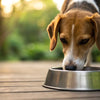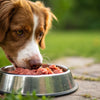What Does Raw Dog Food Mean? A Comprehensive Guide to Raw Feeding for Dogs
- Houndsy
Table of Contents
- Introduction
- Understanding Raw Dog Food
- Benefits of Raw Dog Food
- Risks Associated with Raw Dog Food
- Transitioning to a Raw Diet
- Conclusion
Introduction
Have you ever gazed at your furry friend while they munch on their dry kibble and thought, "Is there a better way to nourish my dog?" You're not alone. A growing number of pet owners are asking themselves this question, especially with the rising popularity of raw dog food diets. According to recent statistics, approximately 10% of dog owners in the U.S. are now incorporating raw diets into their pet's nutrition plan. Such a shift in feeding practices signifies a deeper exploration of canine nutrition and the quest for healthier alternatives.
In this blog post, we're delving into the meaning and implications of raw dog food. We will discuss what constitutes a raw diet, the potential benefits and risks associated with this feeding method, and important considerations for pet owners contemplating this route. By the end of this comprehensive guide, you'll have a clear understanding of the raw dog food movement and be better equipped to determine if it's the right choice for your canine companion.
So, as we embark on this journey into the world of raw dog food, we invite you to reflect on your own pet's current diet. Are there aspects you wish to enhance or change? Let's explore how raw feeding could fit into your pet care philosophy.
Understanding Raw Dog Food
Defining Raw Dog Food
At its core, raw dog food refers to a diet composed mainly of uncooked ingredients, primarily emphasizing raw meat, bones, and organs. However, it can also encompass a selection of raw vegetables, fruits, and supplements. The primary intention behind raw feeding is to mimic the evolutionary diet of wild canines, which thrived on a variety of animal-based foods before domestication.
The definitions and variations of raw feeding have evolved over time, but the two primary approaches include:
-
BARF Diet (Biologically Appropriate Raw Food): Coined by Australian veterinarian Ian Billinghurst, the BARF diet suggests that a dog's diet should consist of 60% raw, meaty bones and the remaining percentage made up of vegetables and other wholesome ingredients. This approach focuses on a holistic view of canine nutrition, advocating for a diet that aligns with a dog's natural eating habits.
-
Prey Model Diet: This method closely mimics the natural prey of wild canines, including the whole animal. For the prey model diet, the proportion of food typically consists of about 80% meat, 10% bones, and 10% organs, reflecting the nutritional profile of prey animals consumed in the wild.
The Rise of Raw Dog Food
The rise of raw dog food diets aligns with broader trends in pet ownership. As health-conscious consumers increasingly lean towards whole and minimally processed foods for themselves, many are extending this philosophy to their pets. The growing interest in raw feeding also follows increasing awareness of nutritional benefits and potential health concerns associated with conventional kibble and canned pet food.
In recent years, the raw dog food market has burgeoned, with estimates suggesting it's worth $169 million a year and experiencing annual growth of about 23%. Pet owners are now more inclined than ever to explore homemade raw diets, commercially available raw foods, and their associated benefits.
Benefits of Raw Dog Food
Improved Coat and Skin Health
One of the most frequently cited advantages of raw dog food is the remarkable difference in coat and skin health. Proponents attest that a diet rich in essential fatty acids from raw meat, along with organ meats and some vegetables, enhances the luster and condition of a dog’s fur. A shiny coat often signifies a well-nourished dog, which can promote overall well-being.
Dental Health and Oral Hygiene
Raw bones are believed to contribute to better dental hygiene. When dogs chew on raw, meaty bones, they're engaging in a natural cleaning process that can promote healthier teeth and gums. The mechanical action of chewing helps reduce tartar build-up and supports oral health, leading to fresher breath and healthier gums.
Higher Energy Levels
Many raw diet advocates report increased energy levels in their dogs. This is often attributed to the higher protein and fat content of raw diets, which can provide dogs with more sustained energy throughout the day. For active dogs, a raw diet may provide the necessary fuel to thrive in their daily activities.
Smaller, Firmer Stools
Pet owners frequently notice a positive change in their dogs' stools when they switch to a raw food diet. Raw diets are typically lower in carbohydrates, resulting in firmer, smaller stools. This is often a reflection of improved nutrient absorption and digestion, as whole, raw ingredients contribute to a more digestible diet.
Nutritional Transparency
A significant advantage of homemade raw dog food is the level of control it provides pet owners. By preparing food at home, dog owners can select the exact ingredients they wish to include, thus avoiding unnecessary additives found in many commercial pet foods. For dogs with specific allergies or sensitivities, raw feeding can offer a tailored solution that meets their nutritional requirements.
Risks Associated with Raw Dog Food
Nutritional Imbalances
While raw dog food can provide numerous benefits, it is crucial to consider the potential for nutritional imbalances. Many pet owners may struggle to create a balanced raw diet that meets their dog’s unique nutritional needs. For example, dogs require specific ratios of calcium to phosphorus to maintain optimal bone health. Without careful planning and understanding, homemade raw diets risk becoming deficient in essential vitamins and minerals.
Pathogen Exposure
One of the most critical concerns about raw feeding is the risk of exposure to harmful bacteria. Studies have shown that raw pet food often harbors pathogens such as Salmonella and E. coli. These bacteria pose risks not only to the dog but also to humans, especially children, elderly individuals, or anyone with compromised immune systems. The Food and Drug Administration (FDA) has advised pet owners to exercise stringent hygiene practices when handling raw dog food to mitigate these risks.
Bone Hazards
While raw bones can aid dental health, they also come with certain dangers. The potential for choking or dental fractures exists, particularly if dogs are given inappropriate bone sizes or types. Additionally, some bones can splinter, posing risks of internal injury, so careful selection and supervision during chewing are essential.
Not Suitable for All Dogs
Raw diets are not appropriate for every canine companion. Dogs with specific health concerns, such as pancreatitis or kidney issues, may require a more carefully controlled diet or alternate feeding methods. Puppies, too, may have unique nutritional needs that could be disrupted by a raw diet lacking balance.
Transitioning to a Raw Diet
Making the Switch
If you're considering transitioning your dog to a raw food diet, gradual adjustment is crucial to prevent gastrointestinal disturbances. Start by slowly introducing raw food alongside your dog's regular kibble, gradually increasing the proportion of raw ingredients over several days or weeks. Monitoring your dog's reactions and consulting with a veterinarian experienced in raw feeding can help ensure a safe and positive transition.
DIY Raw Food Preparation
For pet owners who wish to create a homemade raw diet, a few essential principles should guide the preparation process:
-
Ingredients Selection: Choose high-quality meats, organ meats, bones, fruits, and vegetables that are dog-safe. Always consider sourcing meats that are fit for human consumption to reduce the risk of contamination.
-
Balance: Strive to achieve a balanced nutrient profile, making sure to include a variety of proteins, organ meats, and essential supplements as required. Consulting with a veterinary nutritionist can assist you in crafting an optimal diet.
-
Hygiene: Employ strict hygiene practices in the kitchen. This includes thoroughly washing your hands after handling raw food and sanitizing all surfaces and equipment used in food preparation.
Considering Commercial Raw Options
For those who prefer a more convenient option, several companies offer commercially prepared raw dog food that is formulated to meet AAFCO nutritional standards. These products are pre-packaged, balanced, and often frozen, making it easier to feed a dog a raw diet without the time commitment of meal preparation.
Conclusion
As we wrap up our exploration of raw dog food—the benefits, risks, and thoughtful considerations—it's essential to weigh these elements when making feeding decisions for our beloved pets. The shift toward raw dog food diets reflects a growing recognition of the significance of nourishment in our dogs' lives.
So, what does raw dog food mean for you and your furry friend? It offers a chance to step into a holistic approach to canine nutrition while fostering a deeper bond over mealtime choices. Whether you choose to venture into homemade raw feeding, stick with a high-quality commercial option, or continue with traditional kibble, the key is to prioritize your dog's health and well-being.
Ready to elevate your dog’s feeding experience? We invite you to check out the Houndsy Kibble Dispenser—a perfect blend of design and functionality that makes feeding convenient and aesthetically pleasing. Order now: Houndsy Kibble Dispenser.
FAQ
Is raw food healthy for dogs?
Raw food can be beneficial for many dogs, but it is not without risks. A well-balanced raw diet may lead to improvements in coat quality, energy levels, and dental health. However, pet owners should be aware of potential nutritional imbalances and pathogens present in raw meat.
What should a raw dog food diet consist of?
A raw dog food diet typically includes a variety of uncooked meat, organs, bones, and safe vegetables or fruits. The proportions can vary depending on the diet method chosen, such as BARF or prey model.
How do I safely transition my dog to a raw diet?
To transition your dog to a raw diet, gradually introduce raw food alongside their regular kibble. Monitor for any digestive changes and consult your veterinarian for guidance, especially if your dog has specific health concerns.
Are there any dogs that shouldn't eat raw food?
Yes, dogs with certain health issues such as pancreatitis, severe digestive disorders, or immunosuppressive conditions may not be suitable candidates for raw diets. Always consult a veterinarian before making significant dietary changes.
How important is hygiene when handling raw dog food?
Hygiene is critically important when handling raw dog food. Raw meats can harbor harmful bacteria, so washing hands, sanitizing surfaces, and proper food storage are essential to minimize health risks.












